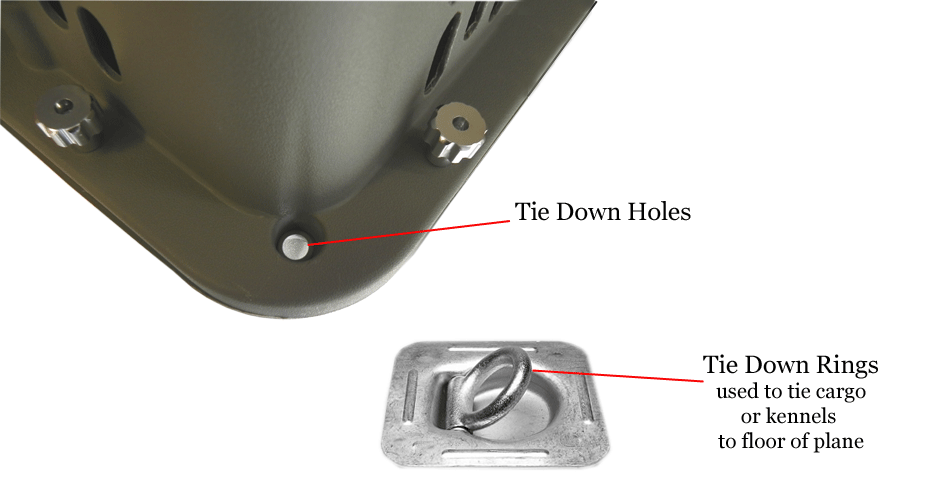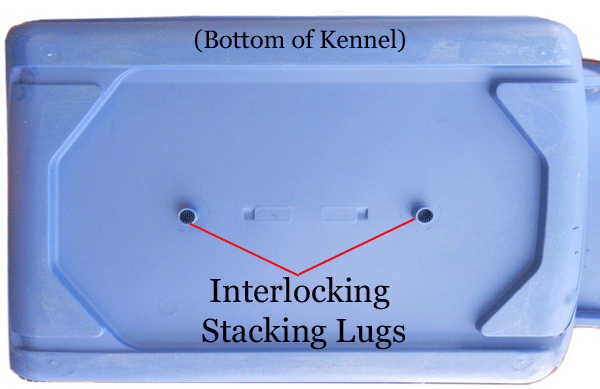Getting ready to shop for a new Dog Airline Kennel, Carrier or Crate? Then you might want to read our latest post detailing what new safety features are available and how exactly they work to keep your airline traveling pets safer. In this post we will examine some of the NEWEST State of the Art Dog Airline Kennels and Crates Safety Features in Detail.
- Pre-Drilled Cable Tie Holes: These 4 small holes are used to secure the kennel door during your pets flight. This is the most effective yet simplest feature ever added to dog kennels. This recent feature has literally saved countless pet’s lives. How they work is simple you just thread a hand releasable cable tie through each hole and through the top metal grate of the door and then fasten the cable ties taunt on the outside of the kennel.
If your kennel is lacking these 4 holes you can easily modify by drilling these holes yourself.
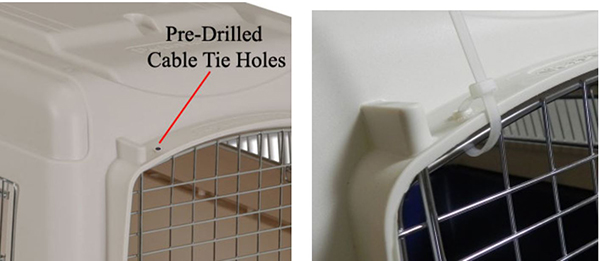
- Covered Door Posts: This feature does not only add a cleaner nicer look it actually has several important purposes. First the solid plastic housing keeps the door posts more stable and secure. They also block anything heavy from falling on top of one of the posts (which are spring loaded) causing the post to be push down engaging the door locking mechanism causing the door to possibly open. I find that Uncovered Door Posts were not much of a safety risk unless the kennel is older, worn out or has lost its original shape. Add to that a heavy pet and I have witnessed the uncovered post being very unstable which caused the door to unexpectedly fall off the kennel.
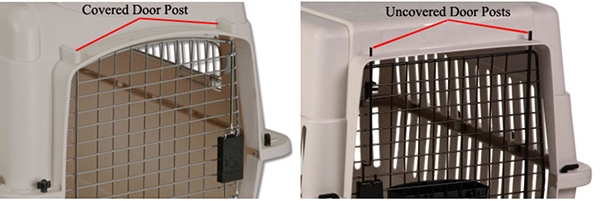
- Enhanced Ventilation: More and more kennels are featuring better ventilation. Some kennels now offer ventilation all 4 sides and other have went one step further and not only have ventilation on all 4 sides but also have added extra ventilation on the lower portion of the kennel as well. When traveling internationally ventilation on all 4 sides is required. Many airline kennels lack ventilation on the rear wall which is acceptable for traveling pets but only on short domestic flights. It is my opinion that you should always provide your dog ventilation on all 4 sides of the kennel regardless of the length of the flight your pet will endure. If you dog’s kennel is lacking ventilation on the back wall you can easily modify it by drilling additional ventilation holes with an electric drill fitted with a 1″ wood bore bit. If your kennel lacks ventilation in the lower portion and overheating is a concern might even be good idea to add a few extra holes there as well. This is the level your pets head (nose) will be located when in a lying down position, but just a few do not over do it or you could compromise the integrity of the kennel.
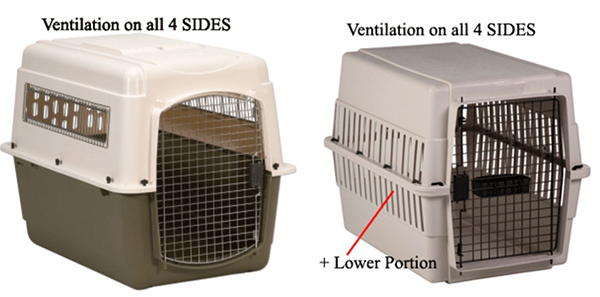
- Flush Door Latch: A very popular feature which dates way back to the Original Sky Kennel days. The Flush Door Latch earned a reputation of being somewhat difficult to operate so many kennel manufactures switched from the Flush Door Latch Design to the Protruding Door Latch Style because pet owners found it much easier to use, which is convenient for owners with small hands or limitations like arthritis. But since it was so easy to operate it also had a slight risk of opening accidentally if something was to fall on or attach to the protruding latches. With kennel manufacturers focusing more and more on the safety of the pets rather than just the convenience and ease of use the more secure Flush Door Latch has made a strong welcomed come back.
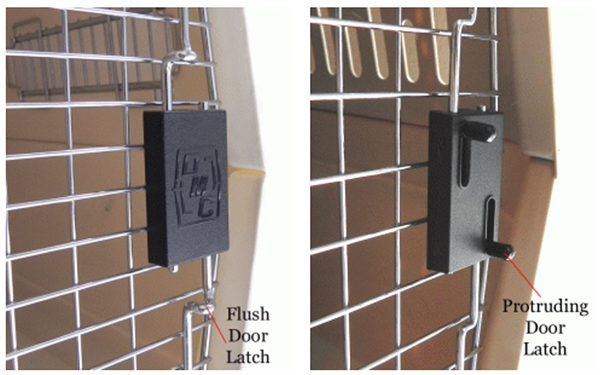
- Improved Fasteners / Attachments: New Airline Kennels feature more fasteners (8 to 18 depending on the size of kennel) and longer bolts insuring the top and bottom of the kennel stay securely fastened together. Older style kennels had only a few attachments usually (3) on each side for a total of only (6) this was standard no matter what size kennel. Under normal circumstances this would not be an issue, but as these kennels aged loosing one or more attachment became common. With only (6) attachments the risk of losing just one attachment could be detrimental to the integrity of the kennels overall structure. This risk intensified if it happened to be one of the (2) attachments next to the door that are not only responsible for keeping the kennel together but also have a secondary function of holding the door in place. If you happen to have an old style Kennel with only 6 attachments you can easily modify by drilling more holes and adding more hardware, a very easy fix and acceptable by all airlines.
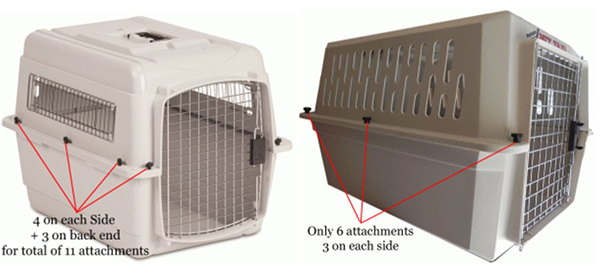
- Tie Down Strap Holes: These 4 Large holes found on the corner of the kennel are an easy way to secure the kennel to the floor of airplanes, trailers, carts or any moving vehicle. The purpose of doing so is to keep the kennels from moving, shifting or accidentally turning over. They function by attaching a bungee cord or rope to the corners of the kennel then tying or attaching the other end to the floor or wall of the moving vehicle. These are very handy for pets who are transported by airline personnel on cargo carts to and from the tarmac. Tie Down Rings (seen below) are readily available on both the cargo carts and in the cargo area of the plane for the purpose of securing kennels and/or valuable cargo in this manner.
- Built in Lift Points (Handholds – Handles): Some airline kennels now feature hand grips on both the left and right sides that function as handles to assist with a two person lift. They are only found on larger sized kennels. This is a great feature it really does assist airline cargo staff with lifting and loading extra large heavy pets especially when the kennel lacks a standard handle on top.
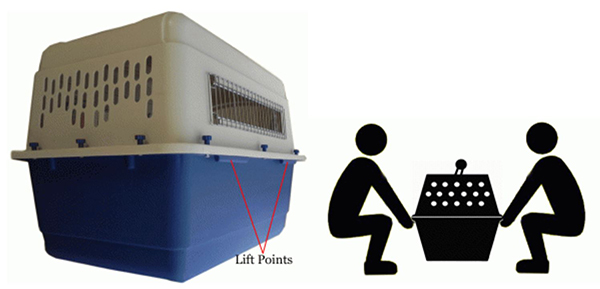
- Interlocking Stacking Lugs: This feature is really not relevant to airline travel or used much for that matter. My thoughts are using them can be kind of dangerous. I would not recommend you ever stack kennels together while traveling or at home the risk of the top kennel falling and harming your pet out weighs any benefits it may offer.

